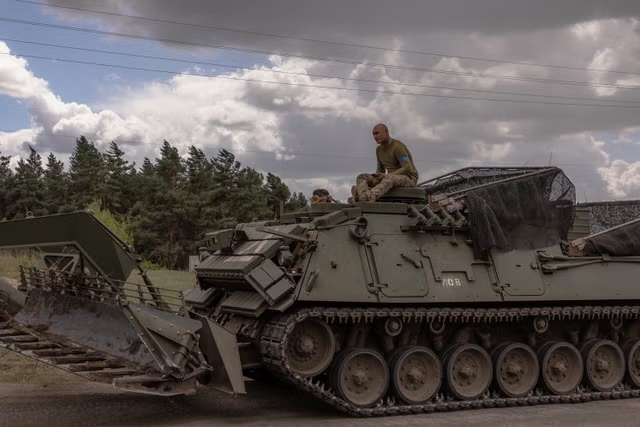The Pentagon this week rebutted concerns about a widening "carrier gap" in the Pacific amid growing competition with China, with two U.S. Navy "flat-tops" having been retasked to the Middle East at short notice.
The flare-up between Israel and Iran forced the U.S. Defense Department to reposition the USS Theodore Roosevelt and the USS Abraham Lincoln, two 100,000-ton Nimitz-class aircraft carriers, from their original deployments in the Indo-Pacific region.
Their arrival will add to the recent surge in U.S. forces in the Middle East and further strength American force posture there as the White House seeks to deter a wider regional conflict, all while maintaining support for Ukraine's resistance against Russia.
West Coast-based Roosevelt and Lincoln had departed Naval Air Station North Island in San Diego in January and July, respectively, for scheduled deployments to the U.S. Seventh Fleet area of operations, which covers the Western Pacific Ocean and the Eastern Indian Ocean.
But the Roosevelt was sent to the U.S. Fifth Fleet's area of responsibility—the Middle East—last month "to deter aggression, promote regional stability, and protect the free flow of commerce in the region," the U.S. Central Command said.
Over the weekend, the Pentagon said the Lincoln, whose air wing includes the stealthy F-35C fighter jet, had been ordered to "accelerate" its transit to the Middle East to join the Roosevelt. The announcement hinted at possible dual carrier operations in the region.
The U.S. Naval Institute's USNI News said the Lincoln was in the Sulu Sea, in the southwestern Philippines, on Monday. Its journey to the Middle East, across the Indian Ocean, could take over a week.
During a press conference on Tuesday, Pentagon press secretary Maj. Gen. Pat Ryder said the U.S. remained appropriately postured for emergencies in both Asia and the Middle East.
"The thing about the U.S. military, as you're seeing this week, is that we have the ability to surge forces and capabilities to where we need them, when we need them," Ryder said.
The Indo-Pacific remains America's "priority theater," he said, "and that is indicative of the number of forces that we have that are located within the region."
Besides the Roosevelt and the Lincoln, the U.S. has four more West Coast aircraft carriers, but none is available to fill the apparent sea power gap.
The USS Carl Vinson was conducting "routine operations and training" in the U.S. Third Fleet's area of operations in the Eastern Pacific, a U.S. Pacific Fleet spokesperson told Newsweek.
Japanese financial magazine Nikkei Asia previously quoted a Navy spokesperson as saying that the ship was due to return to North Island in California.
The USS Nimitz, the lead ship of the class, returned to its home port at Naval Base Kitsap, near Bremerton in Washington state, earlier this month.
Separately this week, the USS Ronald Reagan also pulled into Kitsap, its new home port, for routine maintenance, following a hull swap with the USS George Washington at North Island.
The Washington is to be the new forward-deployed aircraft carrier at Yokosuka naval base in Japan and is expected to arrive in the fall, according to Nikkei Asia.
The U.S. Pacific Fleet still has several ships operating across the Pacific to "maintain the presence and flexibility to rapidly respond to persistent and emergent missions," the fleet spokesperson said.
Besides Seventh Fleet cruisers and destroyers, the Navy can also call on the amphibious assault ships USS America and USS Boxer, both of which carry embarked Marine rapid reaction forces.
The Boxer is currently near South Korea's port city of Pohang for training with allied marines beginning on Monday. The ship, which carries F-35B fighter aircraft, arrived at Busan naval base last week.
The America, another F-35B carrier stationed at Japan's Sasebo naval base, was underway in the Philippine Sea this week, according to photographs published by the Pentagon.
The forward presence of U.S. naval ships in the Pacific, alongside allies and partners, "demonstrates our collective resolve to ensure security and stability in the region," the Pacific Fleet said.
Naval analyst Alex Luck, who writes for the specialist outlet Naval News, told Newsweek earlier this week that the U.S. Navy would be hard-pressed to find like-for-like substitutes for its aircraft carriers.
Discussions about the U.S. military's ability to manage multiple crises across the world come as China sent one of its own carriers into the wider Pacific this week for the second time in just 25 days.
The Chinese navy flat-top Shandong and its escorts were spotted in the Philippine Sea on August 12-13 before returning to the South China Sea, according to the Japanese Defense Ministry.
Disclaimer: The copyright of this article belongs to the original author. Reposting this article is solely for the purpose of information dissemination and does not constitute any investment advice. If there is any infringement, please contact us immediately. We will make corrections or deletions as necessary. Thank you.




